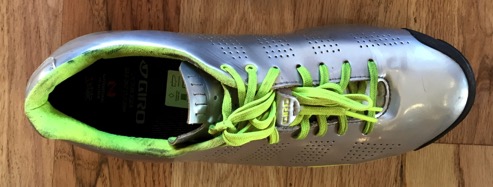10.28.2015 | 11:45 am
A Note from Fatty: The 100 Miles of Nowhere kits are going to start shipping tomorrow; the final thing to arrive — t-shirts — should be arriving today!
I went to the DNA warehouse yesterday to drop product off and take a shot of all the gear (minus the t-shirts).
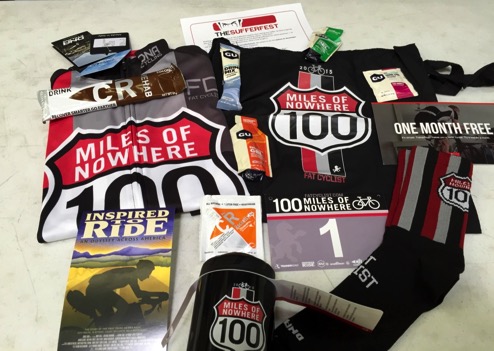
I’m very stoked with the great swag kit that’s going out to 100 Miles of Nowhere racers this year!
Today I’m continuing with my “sometimes you’re the windshield; sometimes you’re the bug” story from yesterday about racing the Ogden Utah Xterra. But first: I want to dwell for a moment on the huge advantages a poor swimmer can get from good equipment. Think about it: with literally no training whatsoever (and I mean the literal meaning of the word “literally” here), I had a 12% improvement over the first time I had done this swim.
Twelve freaking percent.
And I’d say that 100% of that 12% improvement is due to technology: a fantastic wetsuit (the BlueSeventy Reaction) and a GPS (the Iolite).
Think about that for a second: this gear made it possible for a swimmer with very poor form and no training to turn in a pretty reasonable time.
Bike and clothing manufacturers: please make me a bike that makes me 12% faster.
Oh wait, I guess you already have:
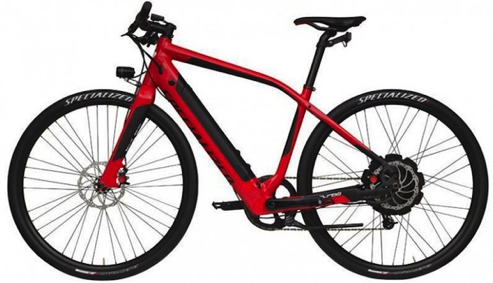
But that’s not exactly what I meant.
The Ride
The first thing I did after finishing the swim was make a huge mistake: I took my time getting ready for the ride.
Now, I wasn’t thinking in terms of “I think I’ll take my time.” I was thinking in terms of “Be calm and deliberate and efficient.”
But the effect was that I was slow and wasted a ton of time. Which The Hammer was gracious enough to record for all posterity.
Here I am, slowly walking to the bike corral:
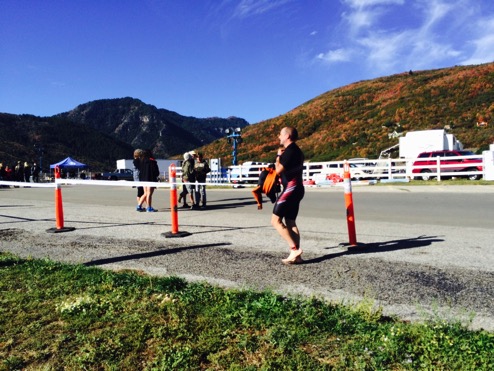
And here I am, leisurely getting out bike clothes:
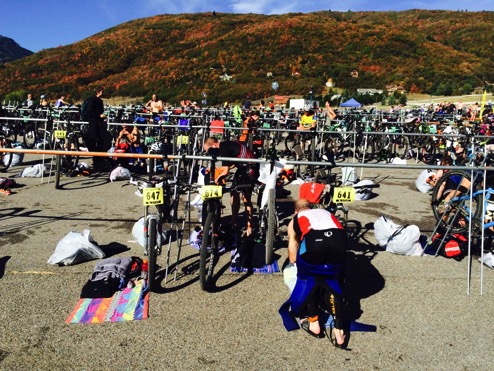
And then getting a nice long drink of water:
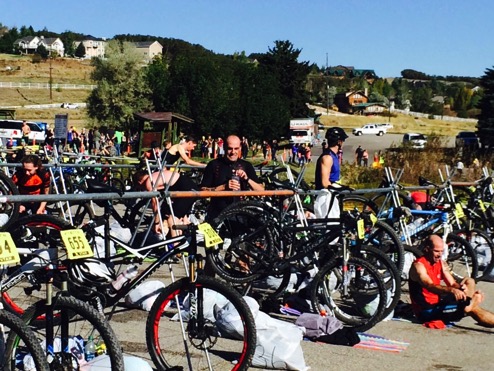
I remember I took especially long to get my socks and gloves on, because my feet and hands were still wet.
Now, there was never any chance of me getting on a podium — I knew that — and so I wasn’t really concerning myself with trying for a fast transition.
If I’d thought about it, though, I’d have hurried. A lot.
Because as I was taking my time getting myself together, a lot of racers who were doing the short version of the race were finishing their swim and starting their ride.
And in short, I was in there a full five minutes, on the dot. About twice as long as most people.
Which means that I was behind a lot of people, right from the beginning of the bike race:
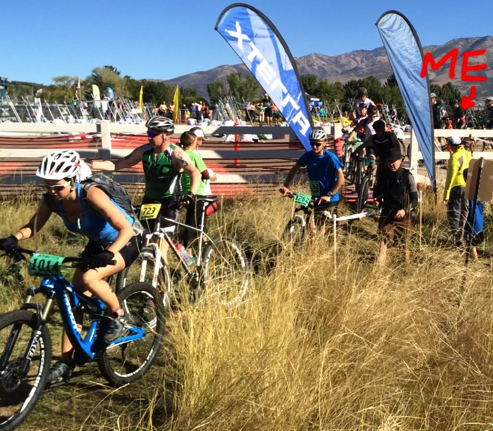
This meant that, right from the beginning, I had a lot of passing to do:
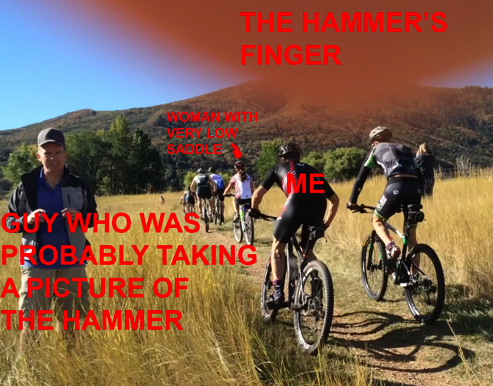
But really, I didnt’ mind. I was on the only part of the race I am good at: the ride.
And I did…OK. Of all the people doing the race, I was the fourth fastest on the bike, and of the men in my age group, I was easily the fastest on the bike (and of the men in the age group I’ll be in next year, I was the fastest by about 13 minutes).
But as far as I was concerned, I wasn’t competing with those people. I was competing with my own times, from previous years (2011 and 2014).
And against my previous-years’ self, I was a full seven minutes slower than my best.
And I knew I was slower.
I knew it before I finished the ride, as I looked down at my GPS and saw how far off my hoped-for pace I was. I knew it when — for pretty much the first time ever on this course — a person passed me on the bike.
I knew it, to be honest, when I put on the one-piece Triathalong outfit the day before the race, and was able to squeeze into it only through a force of will. I knew that my extra pudge was going to be a problem when I did this 17-mile, 3300 feet of climbing mountain bike ride.
The fact is, this part of the race is all about power-to-weight ratio, and I’m not doing so great in the “weight” part of that equation this year.
Which is to say, by the time I finished this ride, my lack of form had been pretty forcefully driven home:
Fancy gear had made me five minutes faster on the swim, but my big ol’ paunch had made me seven minutes slower on the bike.
Hard Questions
And that’s when I started learning the first big lesson of the day: When your self-image depends on you always getting faster, you will eventually be disappointed.
Some day you’ll be older. Or heavier. Or — in my case — both. Some day, you’ll slow down. At that point, you’d better have a new motivation already set up, or you’re going to have a rough time.
Though, to be honest, I didn’t really start processing the lesson until sometime after the race. During the race, I just looked at my Garmin in despair and disbelief.
And even now, I’m having a difficult time dealing with the inevitability that there’s going to be a tapering down of what I’m capable of. I look at my results from this race and don’t see a good, fast time. I look at them and see a seven minute problem.
I don’t look at photos of me from this race and see a guy who is not half-bad for being eight months away from 50 years old. I see a ten pound problem.
And I’m not sure where my problem is: do I need to get in better shape, or do I need to be happy with the shape I have? Do I need to be ashamed at how chubby and slow I have become, or be grateful that I can go as fast as I do?
Should I be upset at having slowed down, or proud that I have enough general fitness that with no training in two of three sports, I can complete an Xterra at all?
These are questions I’m asking myself for real, and while I kind of feel like I know what my answers should be, what I feel is completely different.
And this was only the first of the big lessons this race had to teach me.
The lesson I’d learn in the run would be much more painful.
Which is where I’ll pick up tomorrow.
Comments (26)
10.27.2015 | 12:38 pm
As my good friend Mark Knopfler says, “Sometimes you’re the windshield; sometimes you’re the bug.” I like to write stories in this blog about races where I’m the windshield.
But the fact is, in a couple recent races, I’ve definitely been the bug. And I’m glad. Being squashed during a race teaches you a lot more — about your technique and about yourself — than a good day on the course ever could.
So over the next few days, I’m going to tell the tale of how my 2015 Xterra Utah went, as well as my racing of the Snowbird Hillclimb Ultra.
Spoiler alert: I am not the metaphorical windshield in either of these.
Getting Ready
Let’s begin with a couple of axiomatic assertions, shall we?
- Things don’t have to start badly for them to end badly.
- The best way to exceed expectations is to start with very low expectations.
The 2015 Xterra Utah Long Course race started out very weirdly for me, because The Hammer was not racing alongside me.
No, she didn’t have another race that day. No, she didn’t skip the race because her race plan prohibited it. She just…didn’t race. I had crewed for her at Lotoja, now she was going to crew for me when I did the Xterra.
Which means I started a little off-balance. I’m used to both of us being nervous. I’m used to taking care of both our bikes. I’m used to being the one with the camera, so I don’t have to be in the photos.
This time, though, she was relaxed, I had only my gear to concern myself with, and she had the camera.
Which means that we have photos of things we usually don’t have. Like me setting up my gear at transition 1:
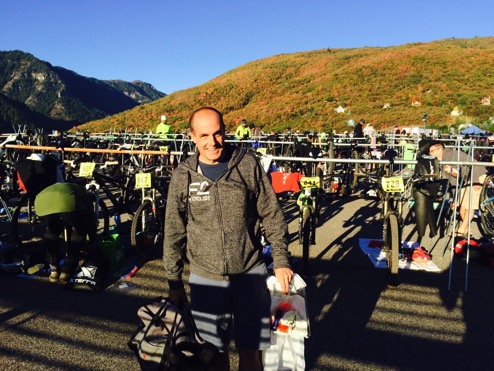
And we have photos of me in my brand-new BlueSeventy Reaction wetsuit:
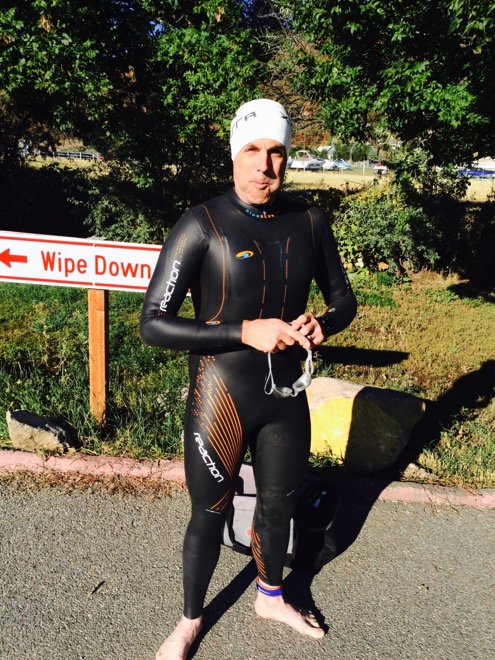
I anticipate you have questions about this photograph. Here are my answers:
- Yes, I am sucking in my gut.
- No, I didn’t know I was standing in front of a sign that says, “Wipe Down,” or I would have posed elsewhere.
- Yes, I am eating in this picture.
Here I am in a more heroic pose, though I still have a mouthful of food:
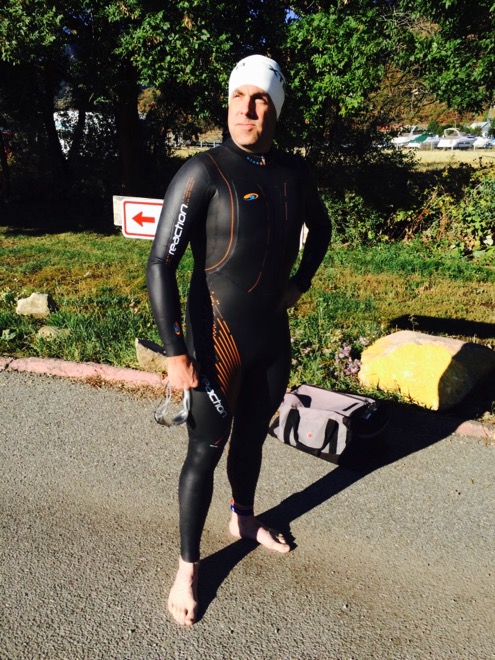
I’ll get to my reaction to this wetsuit — this would be the first time I’d ever worn it while actually swimming — in just a moment, but first I want to show you one more photo, which The Hammer took right after I took a test swim, to warm up:
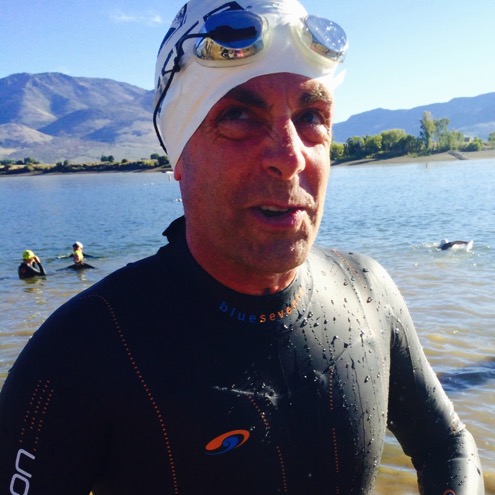
I wanted to show you this partly because it may be the best, most expressive photo ever taken of me. But also, because I am wearing the Iolite Swim GPS on my goggles. The idea behind the Iolite is pretty amazing: a GPS strapped to your goggles on the back of your head hooks up to a little row of LEDs stuck to your goggles in your peripheral vision, and help you swim in a straight line without having to sight constantly.
I had never used this thing, either. So obviously, I was really well-prepared for a fantastic swim.
I Never Expected To Say This
The fact that I had never tried out any of my swimming gear before the Xterra should give you an idea of how serious I take swimming.
But that’s only part of it, really.
Also, I had prepared for this Xterra by literally not having swam even once in almost exactly a year. In fact, the last time I had been in the water to swim had been in this same reservoir (but for a different kind of tri), a year ago.
Here I am at the start of my wave of the race:
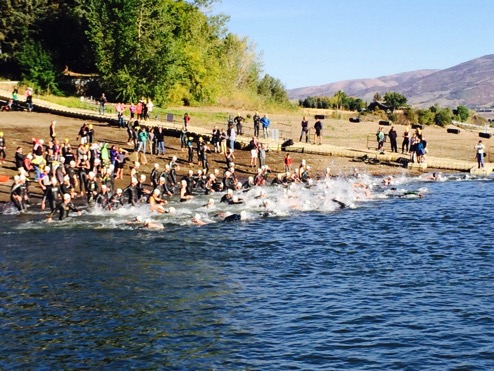
I’m the one in the white swim cap.
Now, as you know, I’m a rider, not a swimmer. Nor a runner for that matter. Doing a triathalong makes no sense at all for me.
So you’ll have to forgive my sense of astonishment that the swim went great.
Really for reals, it did. The Reaction wetsuit was incredibly comfortable and buoyant and non-restrictive, instantly turning me into a much better swimmer than I have any right to expect.
And the Iolite…well, it is an absolute game-changer for me, long-distance open water swimwise. When the LED in my peripheral vision was green, I was doing good. When it showed yellow, I’d glance down to see which way the indicator showed, then course-correct. When it showed red (not often, because I’d usually take care of the course correction as soon as I saw yellow), I’d course-correct sharper.
So even though I was swimming directly into the sunlight, even though I had dozens of swimmers ahead of me, even though I generally can’t swim straight for three seconds, this time I swam more and sighted less, swimming with confidence for pretty much the first time ever.
And it’s so simple to use I was able to work with it easily and flawlessly the very first time I wore it.
I tell you, I love what the Iolite did for me. And believe me, the difference it made for me was huge. The last time I did this course, I very nearly quit during the swim due to confusion and exhaustion, veered all over the place, and took 41:59 to complete it (this is no exaggeration; read my report from the day).
This time — with no swim training whatsoever in a full year — I finished the swim in 36:57. More than five minutes faster, and coming out of the water in much better spirits.
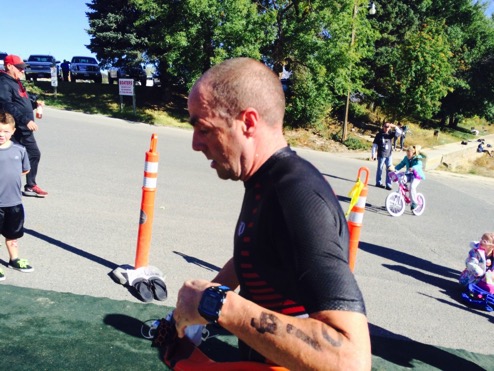
I know, I don’t look like I’m happy, but I am. It’s just that I have my game face on.
I gingerly tiptoed the 100 feet or so to the swim-bike transition, which took me roughly five minutes. Probably thirty people passed me as I did this, and I wished I would have brought shoes or something for getting from the boat ramp to the bike corral. The fact is, I have the tenderest, most sensitive feet you could ever imagine; I never go anywhere (including inside my house) without shoes on.
Now I was ready to begin the only part of a triathalong I’m good at: the bike. And this should be an extra-good course for me, being almost entirely uphill.
I wouldn’t have believed anyone if I’d been told that I had just finished my best leg in this race. Wouldn’t have imagined it as a remote possibility.
But it was true. Things were about to get bad for me. Real bad.
Which seems like a good place to pick up in tomorrow’s post.
Comments (15)
10.26.2015 | 9:19 am
I like to write. Like to do it every day. Maybe that’s why I’ve been writing this blog for more than ten years now.
What’s been kind of interesting to see during this ten years is what kind of things I’ve been focusing on writing. At first it was jokey fake news more often than not. Then a phase where there it was all about pro cycling. Lately, I really enjoy writing long-form multi-part stories about my adventures (races, more often than not).
And for the past week, I’ve been trying to write fiction for Ride 3.
And that has been the most difficult kind of writing I have ever taken on.
Maybe for that reason, I’ve found it really rewarding (and painful).
To be honest, I haven’t finished the story (which means I’ve lost a bet). And to also be honest, it’s gone in a completely different direction than I originally intended.
But I think that it’ll be done by tomorrow, and I’m looking forward to seeing what Keith (the editor and publisher of the Ride anthology series) thinks.
Meanwhile, here’s a little excerpt (for kicks, compare it to where it started). I’d love to know what you think too.
Kokopelli (Excerpt)
by Elden Nelson
By the time Daniel had gotten to Dewey Bridge, he had drifted back far enough that the other three were nowhere in sight. Well, they either filtered water really fast and continued on, or they…just went on, Daniel thought.
He had warned them this was the last place they’d be able to get water ‘til the Westwater Ranger Station, but the day wasn’t hot yet, so Daniel could imagine these guys might have gambled that what they had left would be enough to get them to the Station.
It would not be enough, Daniel knew. “Not my problem,” Daniel said, even though he knew that, when it came right down to it, it would be his problem.
Daniel took one last tug of water from his Camelbak, clipped back in, and began riding. He crossed the river road (Highway 128) onto the desert doubletrack, got into the flow of the ride, and felt clear and strong. Not hungry. Not thirsty. Not tired. Not anything.
To achieve this state: this was why Daniel rode. He stood and and rowed his bike up a short, steep climb. Sat and got low for a short rocky descent. Climbs, descents, flat: Daniel loved it all.
Then as Daniel rode around a blind, banked downhill corner, he saw something in the trail. A big something.
With no time to ride around it — with a rock wall on the left and exposure on the right there was nowhere to go anyway — Daniel grabbed two big handfuls of brake.
People like to talk about time slowing down and everything happening in slow motion when you crash, but that is not what usually happens. Usually, you’re riding and then you’re sliding, with very little time to think in between.
That said, Daniel did have time for two distinct observations either right before or during his endo.
First, he noticed that the rider didn’t move, either before or as Daniel’s front wheel plowed into his torso.
Second — and Daniel was pretty certain this was something he realized as he was in the air, ass over teakettle — he noticed that the rider he had plowed into was Eric.
Daniel rode a lot, but he didn’t fall a lot, so he wasn’t very good at it. Which is to say, he stuck his hands out as he went over, taking his landing on the left hand.
Amazingly, he did not break his collarbone. He didn’t even break his wrist. His left pinky was probably broken, which is about the best possible bone break you can have when you’re mountain biking.
Daniel wasn’t aware of any of these minor injuries in the moments after he crashed, however. He jumped up, the adrenaline hitting him hard and fast. He was in full-on fight or flight mode.
“What happened?” Daniel yelled, realizing as he said it what a strange and vague question it was.
Eric didn’t say anything, but someone did.
“I think he’s dead.”
Comments (19)
10.20.2015 | 3:49 pm
Hi there.
I’m taking this week off from blogging so I can take care of some blog-related stuff. Specifically, I need to take care of some logistical and tactical 100 Miles of Nowhere stuff.
And also, I need to write a story I promised I would write for Ride 3 (I’m not going to finish it by when I said I’d finish it, but I don’t want to bail on the responsibility altogether).
I know, I know. It’s a long time, but I need all of it.
Luckily for you, a story I wrote for Mountain Flyer was just published in their Issue #45. It’s called “Holy Trinity.” And here’s what the opening two-page spread looks like:
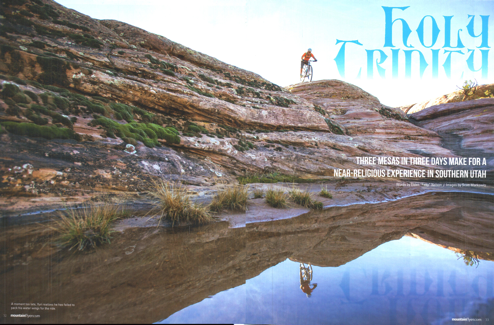
It’s a twelve-page, beautifully-photographed feature about how about this time last year, Yuri Hauswald, Kenny Jones, and I rode all three of the St. George mesas in one amazing three-day weekend.
I’m very proud of the story and astonished at the amazing photographic work the incredible Scott Markewitz did for it. This article is available only in the print version of the magazine, so allow me to recommend you go pick yourself up a copy.
Or three.
Comments (10)
10.16.2015 | 10:37 am
[Disclosure: I paid a discount rate (~50%) for my first pair of Empire VR90s, though I paid normal retail price at a LBS for my second pair and for The Hammer’s pair.]
I was in big trouble last year: I was not enjoying mountain biking. Not enjoying it at all. Why? Pain. Big-time pain. Every single ride. I could not find a pair of mountain biking shoes I could comfortably wear all day.
And I tried. I tried Specialized shoes (several, actually). I tried Shimano. I tried Bontrager. I tried Sidi.
The suffering would not go away.
Finally, I tried some Giro Code VR70s. And with a little help from a local cobbler, I was able to start riding again. More or less.
You may have noticed, though, that this year I haven’t been complaining about my feet at all. That’s because I finally found some shoes that work perfectly for me. Work so well, in fact, that I went ahead and bought a second pair. And a pair for The Hammer. And the road version of the same shoes.
I’m talking about the Giro Empire VR90.
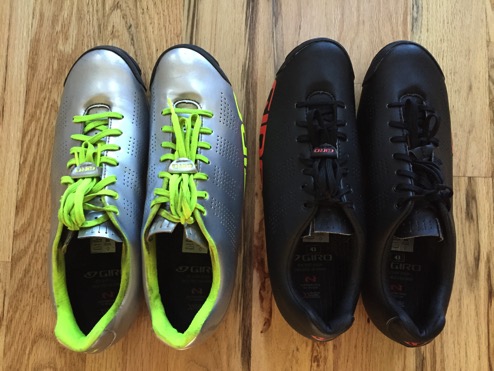
I love these mountain bike shoes. Love them. Let me tell you why.
Fit
In general, I’m hesitant to recommend anything based on fit, because everything fits people differently. That’s why, even though I use one particular kind of saddle (The Selle Italia SLR) on every bike I own, I never talk about it: it’s not going to work for everyone.
So it’s entirely possible that these VR90s aren’t going to make your feet as happy as they make mine.
However, I think it’s a lot more likely that they will fit you well than that they won’t. Why? Because of the laces. Yup, this old-as-dirt fastening mechanism is also the most customizable fit system you could ever imagine. I keep my shoe loose at the front of my right foot, very loose at the front of my left foot, and otherwise snug them in good and tight.
Pain problem: solved.
Laces Questions
Now, when I first got these MTB shoes with laces, I was worried about a few things:
1. Would the laces get caught in the chain? Nope. The shoes come with a little bungee you stick your tied lace under, keeping everything all nice and tied-down, like this:
2. Would I have to double-knot the laces? Nope. At first, I always did double-knot the laces, and then worried about what a pain it would be to have to undo the laces to take the shoes off if I got a rock in the shoes during the ride. Then, as an experiment, I stopped double-knotting the laces, to see how often they came undone. The answer? Never. By the time I got to the Leadville 100, I didn’t even double-knot them for an eight-plus-hour race.
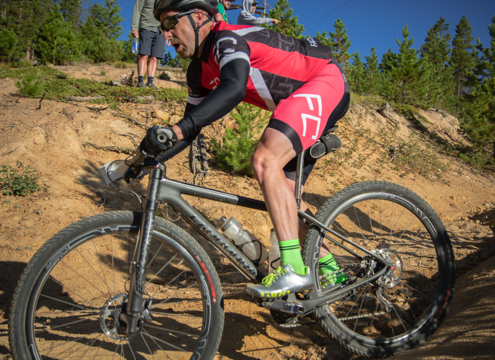
They didn’t come undone the whole day, even with the extensive hike-a-biking I had to do.
3. Are they slower to put on? Yes, they do take longer to put on, snug up, tie, and cinch down than velcro / ratchet / wire-and-dial systems. About a minute longer, I’d say. If that bothers you, these may not be the kind of shoes you want to go with. For me, it’s time very well-spent.
4. What about when the laces break? Of course laces don’t last forever, although the laces I have on my silver VR90s have gone through a full season of near-daily use without looking frayed or ready to break. That said, the VR90s come with a second pair of laces. And unlike other fastening systems (ratchet and velcro systems have problems and dial-and-wire systems are always jamming), lace setups take little time and no tools at all to replace.
And, for what it’s worth, changing the lace colors lets you really customize the look of your shoes:
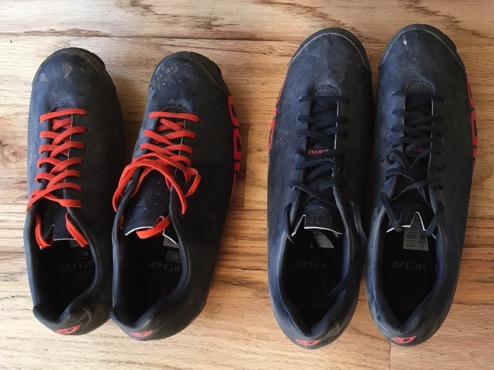
The Hammer likes the orange laces that come with the black shoes; I went with the black.
More About Fit
Giro does a nice job on accomodating a lot of different kind of feet, and it doesn’t end with the laces. The VR90s also come with a couple of different thicknesses of footbeds and different height arch inserts:
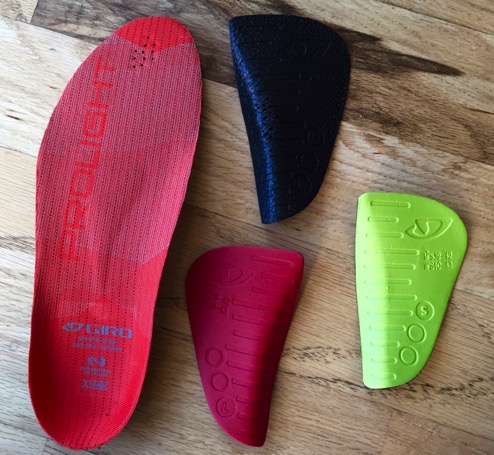
By mixing and matching and experimenting, you’re pretty likely to find something that works for your feet.
Easy to Clean
One thing I did not expect to love about the VR90s is cleanability, but in fact these shoes clean faster and easier than any MTB shoe I’ve ever had. The one-piece Evofiber upper means you don’t have a bunch of mesh for crud to get caught in or leather to take care of. You just spray it with some Simple Green (or Windex or water) and wipe it down with an old t-shirt.
Below, my left shoe is dirty from a few rides, my right shoe is what they look like after about fifteen seconds of attention with Simple Green and a rag.
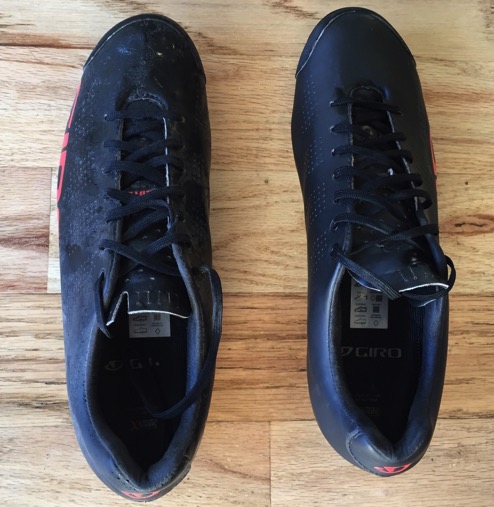
Easton Carbon / Vibram Lugged Outsoles
I do not like hard plasticky outsoles on my mountain bike shoes; I’ve slipped and fallen while hike-a-biking too many times. So I love that Giro uses Easton Carbon outsoles paired with Vibram rubber lugs. Even hiking for about a mile (like at Leadville), I felt sure-footed, while the stiff carbon keeps my shoes from bending while I pedal.
Wrapping Up
Shoes are something you don’t think about at all when mountain biking — until your feet hurt, at which point your shoes are all you think about.
And since moving to the Giro Empire VR90s, I don’t think about shoes anymore.
I love these things.
Comments (17)
« Previous Page — « Previous Entries Next Entries » — Next Page »
















